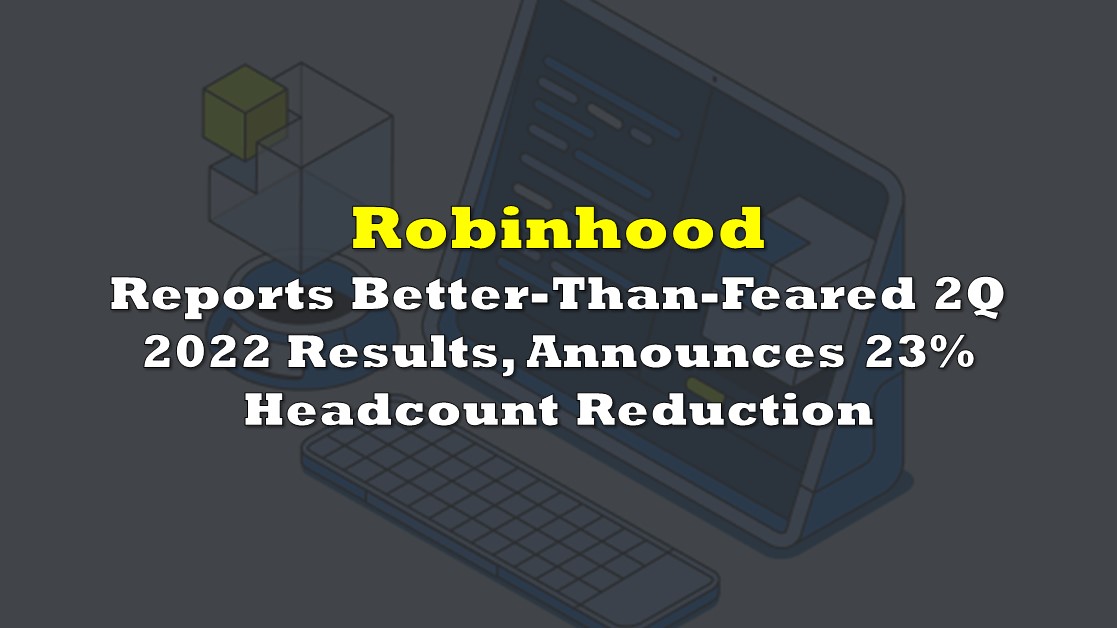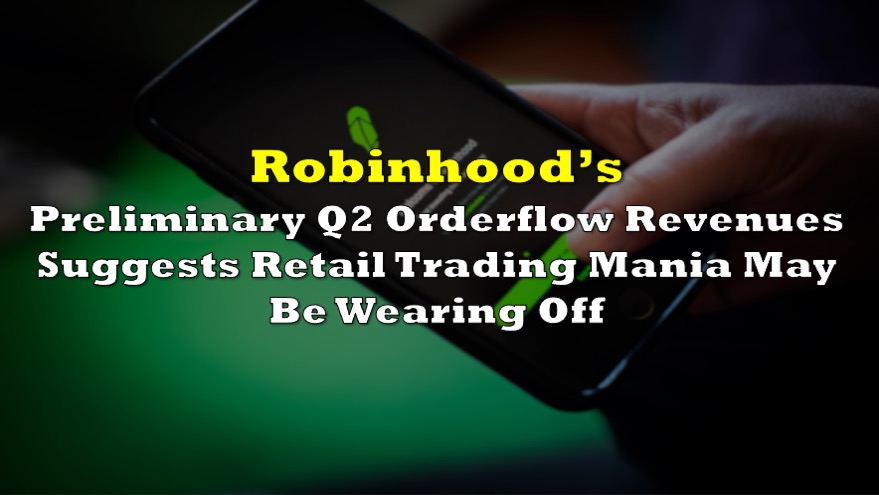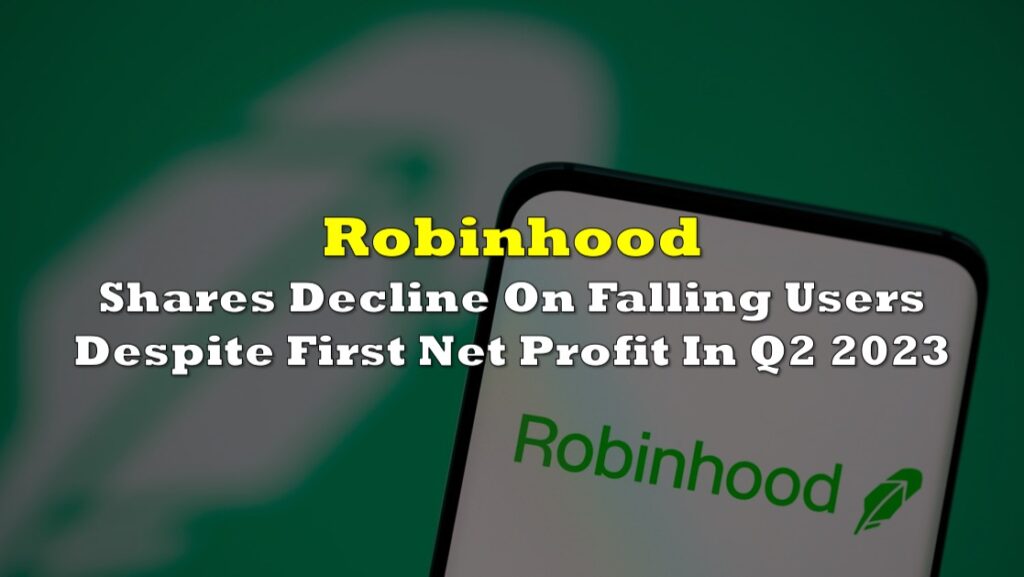After the market closed on August 2, Robinhood Markets, Inc. (NASDAQ: HOOD) announced weak 2Q 2022 results (but results that may be considered better than feared), as well as plans to cut an enormous 23% of its workforce. It appears this includes and is an extension of the 9% workforce reduction plan the company announced in April 2022. Robinhood’s workforce totals about 3,400, so a 23% cut equates to roughly 780 workers.
Robinhood reported a 2Q 2022 loss of US$0.34 per share, narrower than analysts’ consensus projections of a US$0.37 a share loss. Its 2Q 2022 revenue was US$318 million, just shy of consensus estimates of US$321 million.
The most encouraging aspect of the earnings release relates to a marked sequential improvement in Robinhood’s cash flow deficit in the quarter. Its adjusted EBITDA in 2Q 2022 was (US$80) million, much improved from ($143) million in 1Q 2022 and the company’s best quarterly performance on this measure since it posted positive US$90 million of adjusted EBITDA in 2Q 2021.
| Twelve Months Ended 6-30-22 | 2Q 2021 | 1Q 2021 | 4Q 2021 | 3Q 2021 | |
| Cumulative Funded Accounts (millions) | 22.9 | 22.8 | 22.7 | 22.4 | |
| Sequential Growth | 0.4% | 0.4% | 1.3% | -0.4% | |
| Monthly Active Users (millions) | 14.0 | 15.9 | 17.3 | 18.9 | |
| Sequential Growth | -11.9% | -8.1% | -8.5% | -11.3% | |
| Assets Under Custody (US$ billions): | |||||
| Equities | $51.2 | $68.5 | $72.1 | $69.0 | |
| Options | $0.5 | $1.1 | $2.0 | $1.0 | |
| Cryptocurrencies | $8.6 | $19.7 | $22.0 | $22.0 | |
| Net Cash Held by Users | $3.9 | $3.8 | $2.0 | $3.0 | |
| Assets Under Custody (US$ billions) | $64.2 | $93.1 | $98.1 | $95.0 | |
| Sequential Growth | -31.0% | -5.1% | 3.3% | -6.9% | |
| Average Account Balance (US$) | $2,803 | $4,083 | $4,322 | $4,241 | |
| Sequential Growth | -31.3% | -5.5% | 1.9% | -6.4% | |
| Average Revenue Per User (US$) | $56 | $53 | $64 | $65 | |
| Sequential Growth | 5.7% | -17.2% | -1.5% | -42.0% | |
| Options PFOF Revenue | $567,000 | $113,000 | $127,000 | $163,000 | $164,000 |
| Cryptocurrency PFOF-Type Revenue | $211,000 | $58,000 | $54,000 | $48,000 | $51,000 |
| Equities PFOF Revenue | $167,000 | $29,000 | $36,000 | $52,000 | $50,000 |
| Other PFOF Revenue | $6,000 | $2,000 | $1,000 | $1,000 | $2,000 |
| PFOF or PFOF-Type Revenue | $951,000 | $202,000 | $218,000 | $264,000 | $267,000 |
| All Other Revenue | $394,000 | $116,000 | $81,000 | $99,000 | $98,000 |
| Net Revenue | $1,344,713 | $318,000 | $299,000 | $362,713 | $365,000 |
| Sequential Growth | 6.4% | -17.6% | -0.6% | -35.4% | |
| Adjusted EBITDA | ($393,843) | ($80,000) | ($143,000) | ($86,844) | ($83,999) |
| Cash | $5,962,000 | $6,191,000 | $6,253,477 | $6,166,705 | |
| Debt | $154,000 | $203,000 | $151,000 | $0 | |
| Shares Outstanding (millions) | 878.3 | 869.8 | 863.9 | 835.7 |
The reason for the improvement: Robinhood is starting to address its (excessive) cost structure. For example, technology and development expenses decreased to US$244 million in 2Q 2022 from US$266 million in 1Q 2021 and US$280 million in 4Q 2021. G&A costs fell even faster: US$226 million in 2Q 2022 from US$268 million and US$332 million in the previous two quarters.
There were negatives in the quarter as the investment environment is far less favorable than it was a year ago for many of the securities and commodities that Robinhood users traditionally have liked to trade, including tech stocks, cryptocurrencies, and equity options. For example, monthly active users fell to 14.0 million in 2Q 2022 from 15.9 million in 1Q 2022 and 17.3 million in 4Q 2021. Even more alarming, the average balance of a Robinhood account holder plunged about 31% in just one quarter to US$2,803 on June 30,2022 from US$4,083 on March 31, 2022.
Separately, there has been no resolution regarding the SEC’s continuing interest in curtailing the popular online brokerage firms’ practice of payment for order flow (PFOF). In late June, U.S. SEC Chairman Gary Gensler continued his blistering attacks on PFOF and, most importantly, signaled that he plans to make it more difficult for a firm like Robinhood to continue to rely on the trade routing methodology that accounts for about half its revenue.
Under PFOF, an online brokerage firm directs clients’ — primarily retail investors’ — orders to market makers in exchange for fees. The PFOF technique, which allows Robinhood to charge no commissions, is derided by full-service brokers who contend that the practice results in a less favorable transaction price for the online broker’s clients.
Robinhood’s stock market capitalization is about US$8.1 billion, about US$5.8 billion of which is supported by its net cash position making its enterprise value only around US$2.3 billion. Robinhood’s shares are down around 90% from its all-time high achieved almost exactly twelve months ago. With its cash flow improving in spite of a difficult macro backdrop in 2Q 2022, and ongoing expenses promising to fall even further after the 23% headcount reduction (cutting 780 employees could potentially equate to around US$100 million in lower costs), it would seem prudent, at the very least, to consider covering Robinhood short positions.
Robinhood Markets, Inc. last traded at US$10.42 on the NASDAQ.
Information for this briefing was found via Edgar, Bloomberg, and the companies mentioned. The author has no securities or affiliations related to this organization. Not a recommendation to buy or sell. Always do additional research and consult a professional before purchasing a security. The author holds no licenses.









